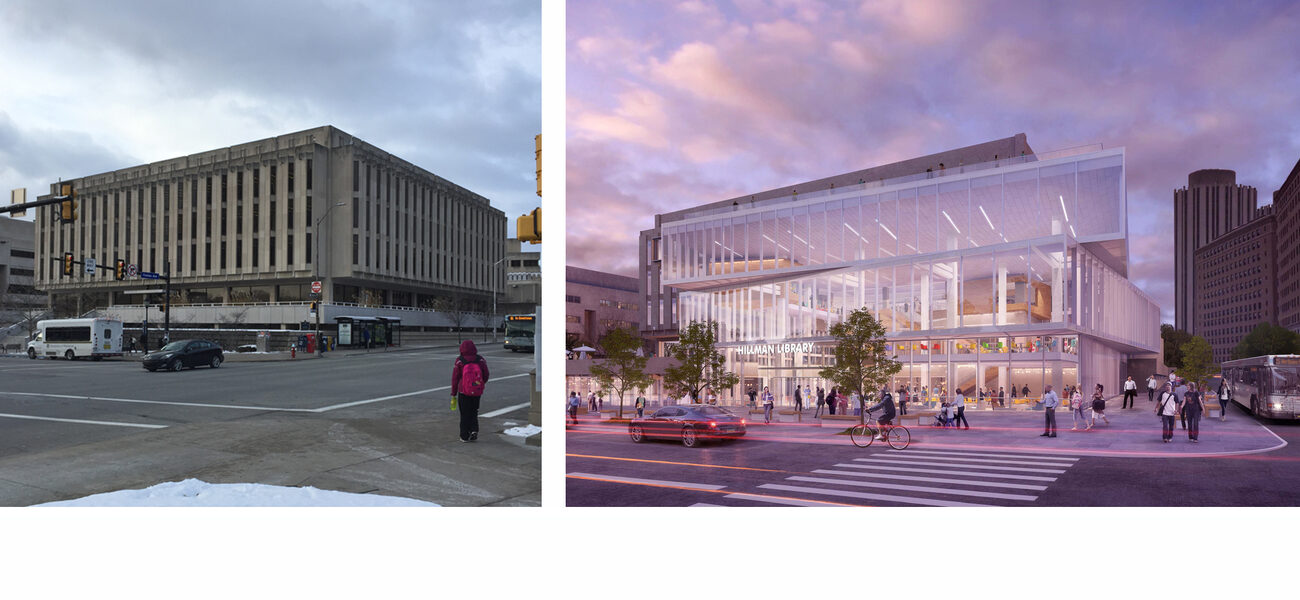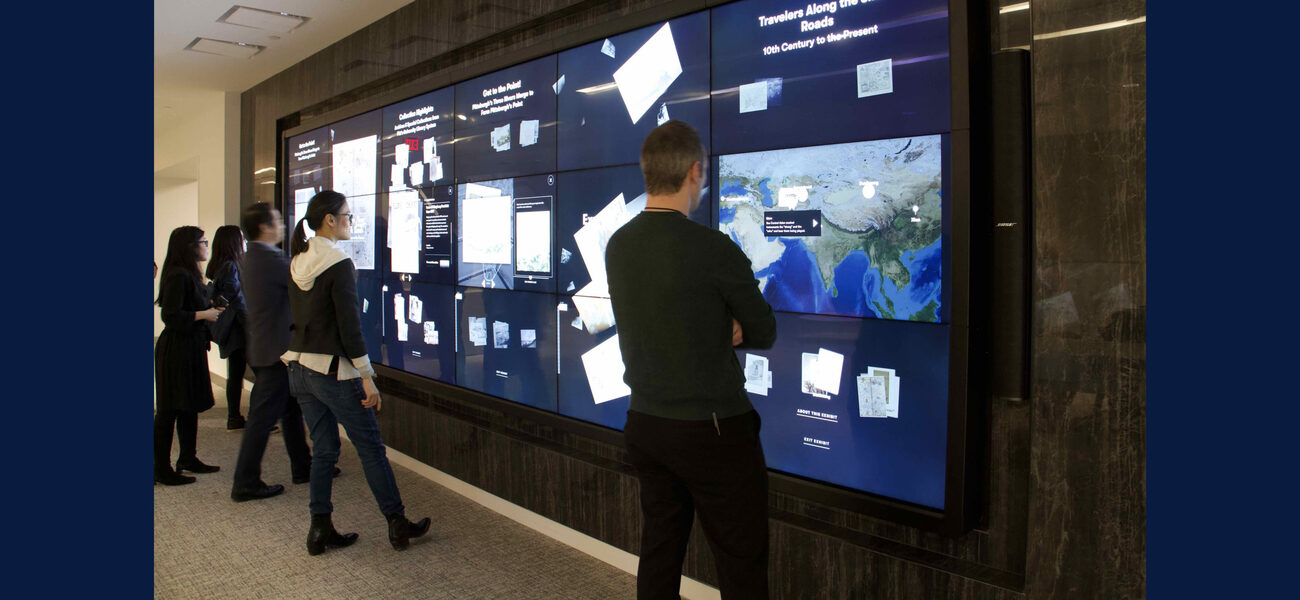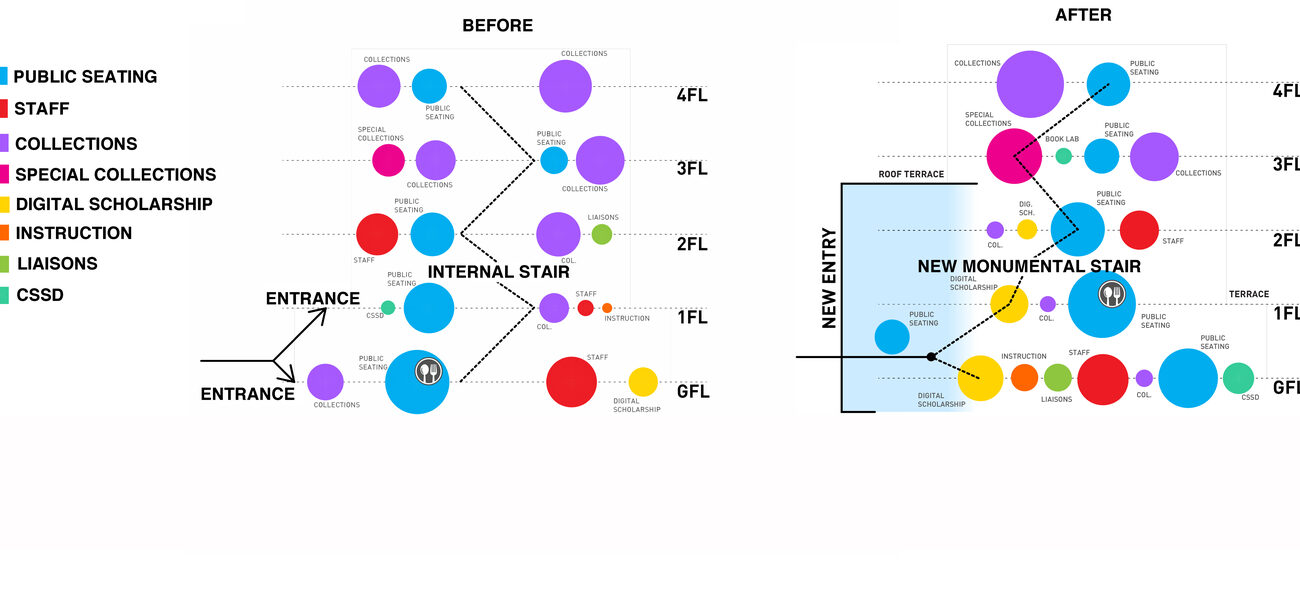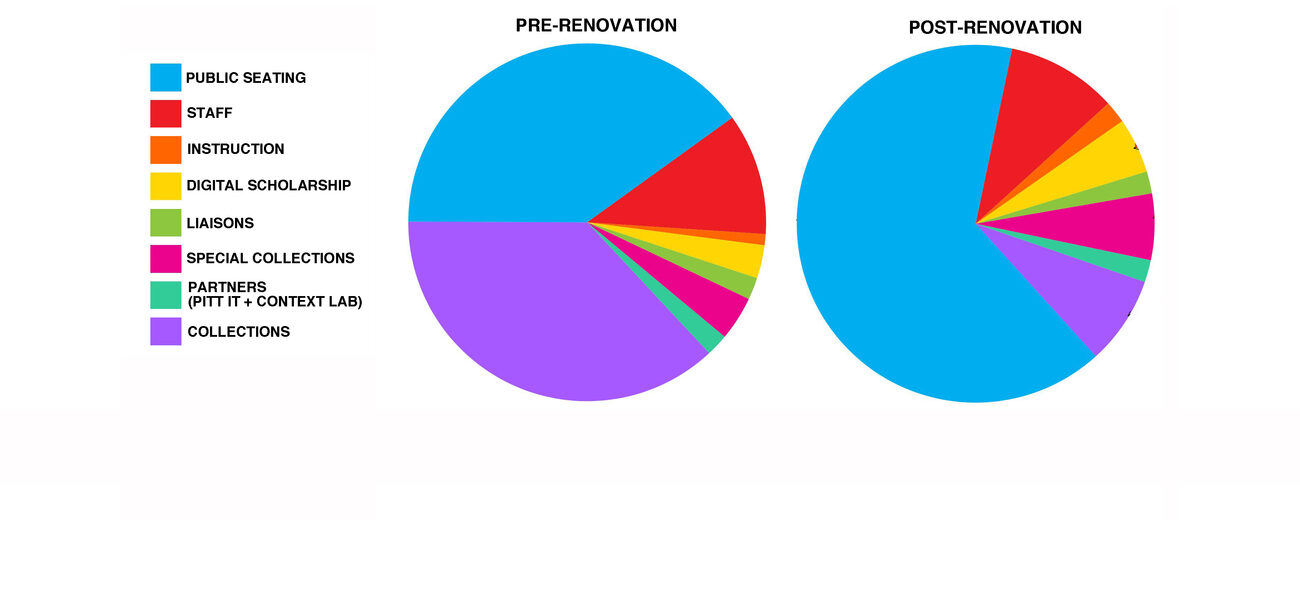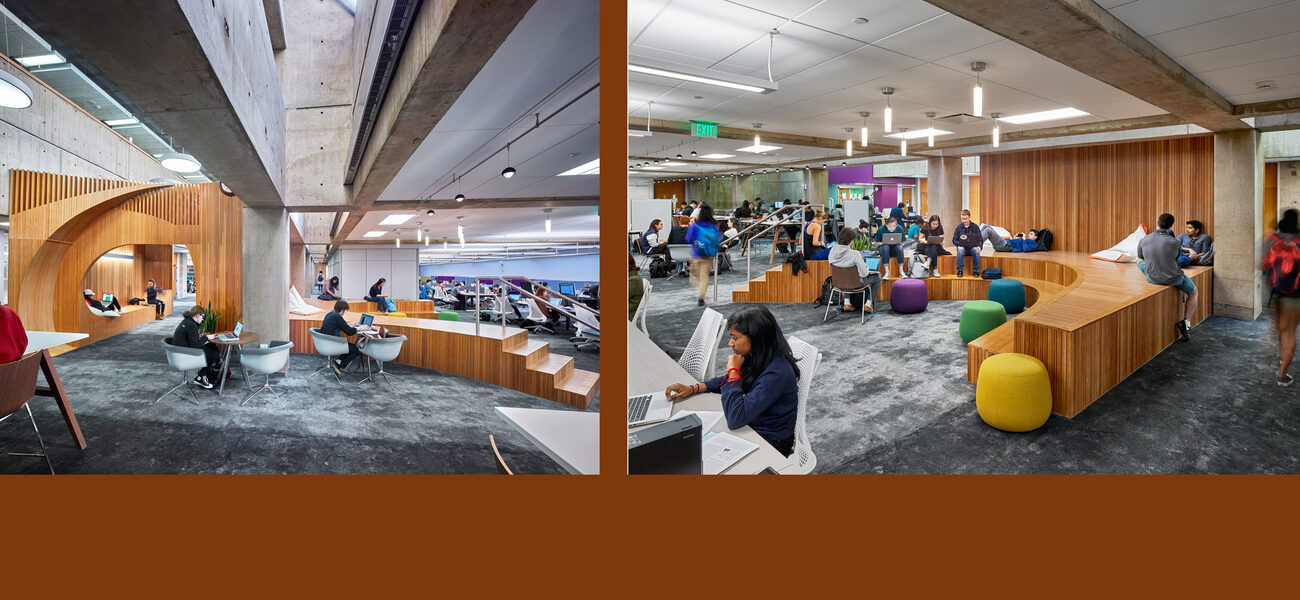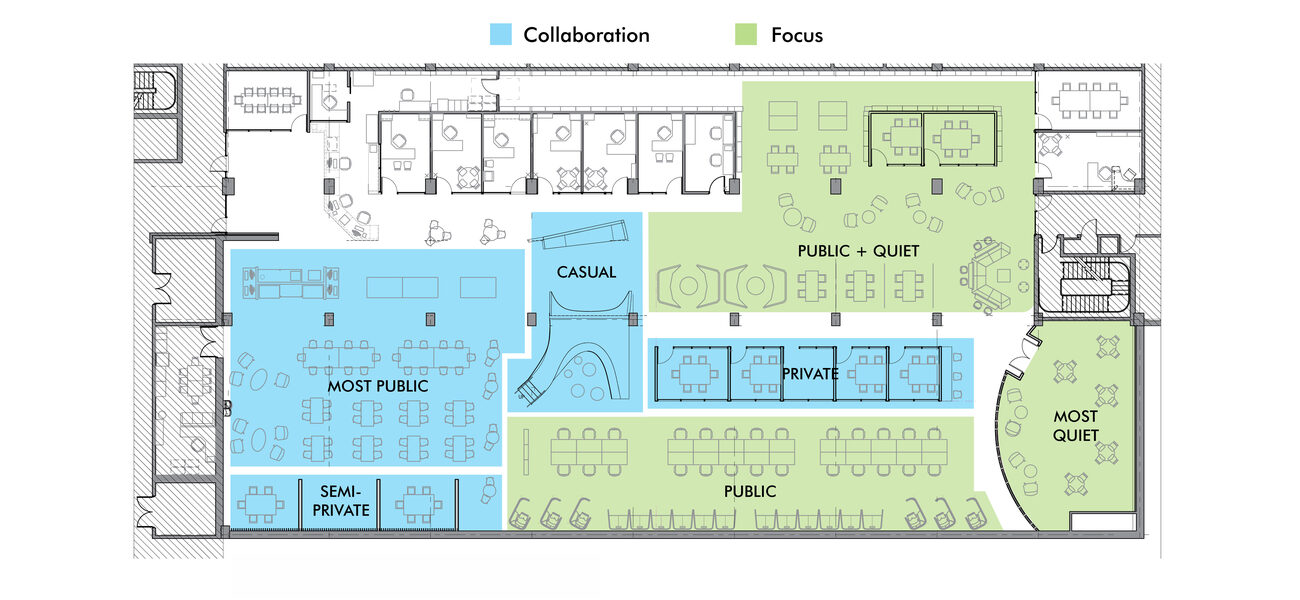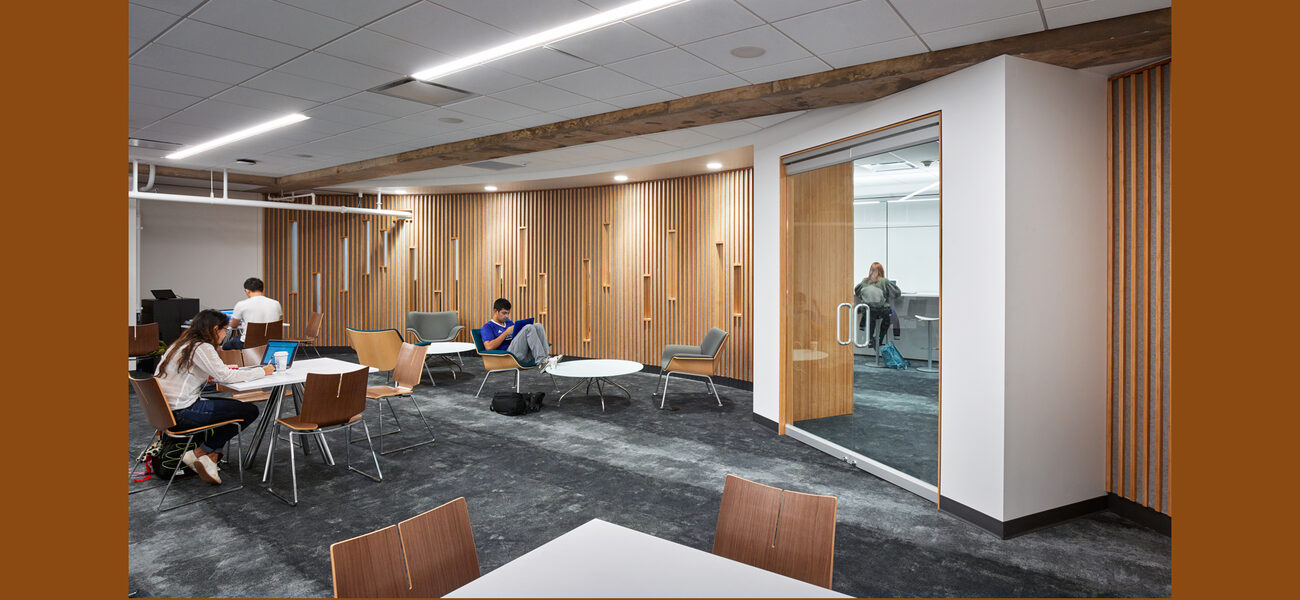Academic libraries are radically reprogramming spaces and services to connect students to validated digital information and the expertise of library staff. Space that once housed printed information is being opened for people to collaborate and create. When the multi-year, multi-phased University of Pittsburgh Hillman Library renovation is complete, it will add 401 seats (a 15 percent increase) and enhanced digital services in a welcoming environment that inspires discovery. At Carnegie Mellon University’s Sorrells Engineering and Science Library, reprogramming and a few strategic design moves have resulted in 115 percent increase in user occupancy.
To better support 21st century students and the campus community, the 230,000-sf Hillman Library project addressed three primary program enhancements:
- Creation: Digital resources – data visualization and making
- Discovery: Digital browsing of Special Collections and unique research
- Discourse and Dissemination: Supportive space for study and research accommodating both focused study and interdisciplinary collaboration; forum for intersection between the academic and civic communities
How do you draw students deep into the information universe? The renovated spaces invite people to use them, with access to daylight and views, new lighting, and intentionally shaped study and collaboration areas. The Hillman Library transformation at the University of Pittsburgh also provides a welcoming, new entry and monumental stair that promotes intuitive navigation, with robust digital programs and offerings strategically and prominently located along it. Spaces that will become destinations for users, such as a lively café, are used to expand the primary circulation path. Priorities included digital services—from vehicles for sharing unique resources to innovative instruction and maker spaces—and the library’s distinctive special collections.
Creation: Digital Resources
At Hillman, several distinct spaces make up a “library laboratory,” where researchers and students use tools to visualize, evaluate, and communicate data in ways that unlock information and create pathways to further discovery. The Open Lab, for example, provides a dedicated area for virtual and augmented reality and physical modelling tools. It is located towards the back of the first floor, visible from the main circulation but not on it, which makes room to display original university research in an interactive exhibit. The Open Lab is where the liberal arts student and the biological science major can learn to use laser cutters and 3D printers—equipment that in an engineering school maker space would be intimidating or inaccessible. Display for creative output—like 3D models and graphic visualization—and strategies that use daylight, display, and architectural features pique curiosity and attract visitors to this space off the beaten path.
Librarians have always specialized in connecting researchers to physical and digital resources—including databases, journals, maps, and books—but also resources to create and better understand data. Librarians are also matchmakers. They connect the music major and the biophysics graduate student, so they can collaborate on a prototype for a device that helps deaf people translate vibrations to sound. They help the engineer, the designer, and the sociology major find each other to develop the user interface for a health monitoring system. These cross-disciplinary, project-based innovations can develop in the library through shared project rooms that have whiteboards, displays, and assigned lockers for storing materials.
Discovery: Digital Browsing
At Hillman Library, a large interactive display, designed to promote discovery through exploration, provides access to the library’s Special Collections archives. Up to six people can use it simultaneously, all accessing unique content like maps, timelines, rare books, photographs, videos, and 3D objects in the archives. Along with the artifacts is information about where the physical object is located, and contact information for the appropriate specialist to aid in deeper research. Unique collections typically protected behind locked doors, for example Hillman’s newly acquired August Wilson archive, can be easily browsed, inspiring curiosity for further exploration and research. Curiosity is contagious—when people see others using the display, they want to use it too. Interactive displays planned in another area of the library will broadcast research in progress, or the collected research output of the University, inspiring interdisciplinary connections that might advance that research in previously unimagined ways.
Discourse and Dissemination: Study and Collaboration
As both the Forum and the “kitchen table,” the library attracts diverse people. They come to study and collaborate, advance research, debate, and disseminate ideas. It’s a neutral space that belongs to all—the steward of civil discussion. It’s where the undergraduate can sit comfortably next to the Ph.D. student, and where a researcher can practice sharing work with a wider community audience. Library spaces must be both specific and flexible enough to support all of this.
At Hillman Library, multiple study spaces also serve as event spaces for faculty book discussions, debates, or receptions. These spaces provide flexibility for multiple scales, from a café that can be visually open but acoustically isolated from other areas of the library, for larger presentations to smaller more intimate rooms that open to library-controlled outdoor space. Enhanced technology for displays and presentations helps the library establish and reinforce connections within the academic community, and with the civic community.
Despite the near continual state of renovation at Hillman over the past two years, a 2019 survey of students identified some positive shifts from pre-renovation in perception of the library as a destination for collaboration and camaraderie. Likelihood to use the library for school-related work increased 8 percentage points. Likelihood to use it for group study increased significantly (up 16 points, compared to just a 2-point increase in likelihood to study alone). Using the library to meet with friends and for relaxing between classes also increased (up 16 points and 13 points respectively). These gains were observed among both graduate and undergraduate students, signaling that even at this early stage of the renovation, students increasingly see the campus library as a welcoming destination. Hillman’s fourth floor has been popular with students since it opened in 2018: 70 percent of students who visit spend three or more hours at a time, and group study rooms are booked 38 percent more often than the study rooms on other floors.
Sorrells Library
Like Hillman, Carnegie Mellon University’s Sorrells Library is also a Brutalist building. To accommodate the updates, and to prioritize people over paper, CMU moved approximately 90 percent of printed matter to off-site storage and kept 12,000 frequently used volumes on site.
Four prefabricated bamboo millwork insertions articulate several different engagement zones and empower students to choose how they learn within a larger communal setting. The zone nearest the entrance and circulation desk is the most active. Furthest from the entrance is a den-like space that supports digital scholarship and can accommodate still larger groups or classes.
Modular project rooms act as a buffer between solitary workspaces and a more social lounge area. The different spaces were designed to be readily understandable when people enter the library, eliminating the need for signage indicating what areas are quiet or active. Strategically developed to minimize library service disruption, on-site construction was limited to one month between semesters. Designed by GBBN and locally fabricated by two CMU alums, the bamboo millwork was installed in just two weeks.
Gate counts at Sorrells Library increased 115 percent post-renovation. This usage pattern has been sustained over subsequent years, indicating the library’s ongoing popularity with students.
Academic libraries are central hubs for university communities. They are uniquely positioned to serve the whole student, from their academic achievement to career success and thought leadership in their chosen professions. This trajectory is nourished by librarians who help students turn curiosity into passion and information access into groundbreaking research, and use state of the art technology and powerful tools that advance data interpretation and visualization, along with teaching and learning.
With spaces designed for people, academic libraries become as flexible, adaptable, and resilient as the users they serve. Whether accommodating safe physical distancing in the COVID world of today or the new teaching paradigms and research tools of tomorrow, academic libraries have the unique ability to adapt to the scholarly needs of generations to come.
By Anne Chen
Anne Chen, AIA, LEED AP, is a principal at GBBN.
